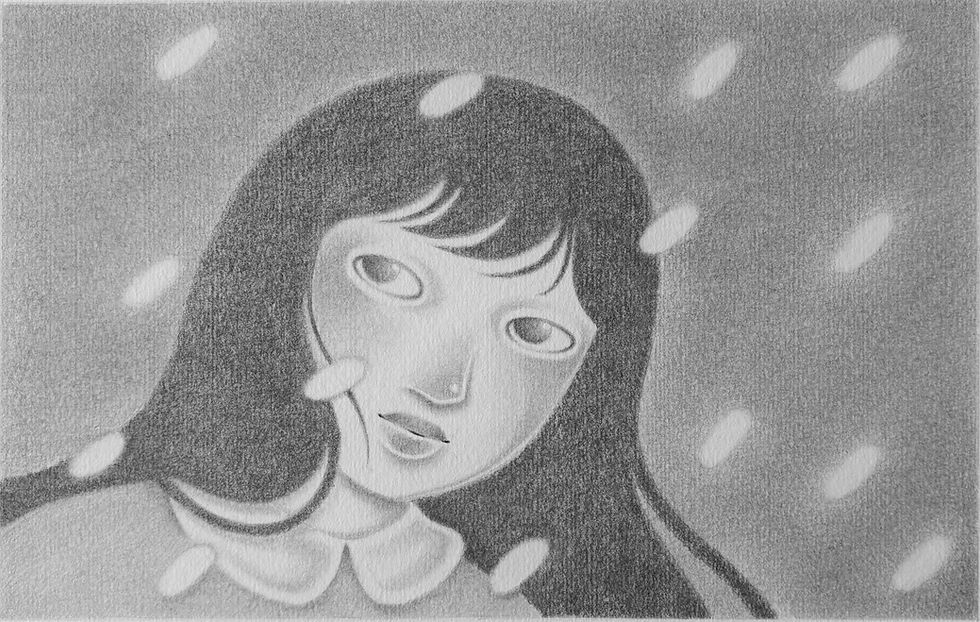Chiara De Lisi
- Anna Lilli Garai
- Sep 26
- 4 min read
Chiara De Lisi, known as Chiakia, is an Italian artist working in painting, sculpture, and illustration. Her work often explores fragility, memory, and femininity through quiet atmospheres and small details. In pieces like “Tenderness,” she brings together softness and turbulence, showing figures caught in moments of reflection and change. Growing up in a multicultural environment shaped her sensitivity to gesture and silence, which now carries through her practice. Her paintings and drawings create spaces that feel intimate and contemplative, inviting viewers into a slower, more attentive way of looking.

Q: You grew up in a multicultural environment where words often gave way to gestures and silences. How has that shaped the way you tell stories in your work?
A: Living in the rhythm of many voices taught me to pay close attention to the spaces in between moments when communication relied more on feeling than on vocabulary. I became attuned to subtle cues: posture, movement, energy. That sensitivity influences how I create. My work leans into suggestion rather than explanation. I’m more interested in what can be sensed than what can be clearly defined.
The images become vessels for emotion, shaped by the things we don’t always know how to say aloud.

Q: Much of your practice explores the line between fragility and strength. What draws you back to that tension again and again?
A: I’m continually fascinated by how delicate things can endure. There’s a quiet bravery in openness, in letting something remain gentle in a world that often demands hardness. That contrast has always felt deeply human to me.
I revisit it because it holds endless nuance; it speaks to both personal experiences and broader emotional truths. I don’t seek to resolve the tension. Rather, I trace its contours, because it feels like the most honest place to be. Resilience doesn’t always wear armor; sometimes, gentleness is the braver choice, a way of honoring the quiet complexity of being both tender and unbreakable.
Q: "Tenderness" you painted a figure caught between storm and calm. How did that piece mirror your own process of healing?
A: It began in a moment where something inside me shifted, and I couldn’t turn away from it. I was learning not to rush past discomfort, but to hold space for it, to acknowledge the turbulence without trying to silence it. The figure reflects that balance: not entirely consumed by chaos, but not untouched by it either. Creating it was a way to process vulnerability, to find a sense of grounding in the midst of uncertainty. It marked a shift in how I approached both my art and my own inner world, with more care, more patience. This painting taught me that transformation begins the moment we stop resisting it. Creating it made me realize: change doesn’t ask for certainty, but for willingness.
Q: Softness and vulnerability appear in your work not as weakness but as power. How do you see softness working against the world’s demand for toughness?
A: Choosing to remain vulnerable and open in a world that rewards defensiveness is, in itself, an act of rebellion. There is a quiet rebellion in choosing to feel deeply when numbness is the norm. There’s courage in gentleness, in allowing yourself to be moved, affected, and empathetic. My practice allows me to reframe what the world often dismisses, revealing tenderness and vulnerability as forms of strength. Softness doesn’t mean passivity; it can hold intensity, depth, and clarity. It invites connection in a world that often leans toward separation. Through my work, I aim to affirm that sensitivity has value, and that it can reshape the spaces we inhabit.



Q: Your paintings and illustrations often hover between presence and absence. What do you want viewers to experience in that in-between space?
A: I hope they feel a sense of stillness, an opening into something quiet and reflective, a space to pause, to rest, and perhaps recognize some small part of themselves within it. The undefined edges and muted tones are there to slow the gaze, to create a pause. The space between visibility and erasure evokes a more intuitive understanding. I want people to linger, to feel something personal stir up, perhaps a memory, or a mood they can’t quite name. It’s in that ambiguity that emotion becomes more expansive, more deeply felt.

Q: Memory and femininity run through your practice. How do you keep those themes alive without repeating yourself?
A: I treat both as living, shifting elements rather than fixed motifs. They show up differently depending on where I am emotionally or creatively. Sometimes they surface in the structure of a piece, other times through gesture, detail, or atmosphere. I try not to approach them with expectation, but with curiosity. They evolve alongside me, shaped by what I’m uncovering in myself and in the world. That ongoing process ensures the work stays honest, and that the themes continue to unfold in unexpected ways. For me, memory is fluid, it shifts depending on where I am, what I’m holding, what I’m ready to revisit. Femininity, too, is not a static idea but an evolving language I continue to rewrite. It reveals itself not only through symbols or visual choices, but in how I relate to tenderness and resilience, to care, intuition, and the shifting contours of identity. These themes live in my work because they live in me. As I change, so do they. What keeps them alive is my willingness to keep asking, to stay curious, to let them unfold in new and sometimes surprising ways.


